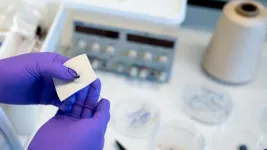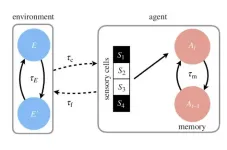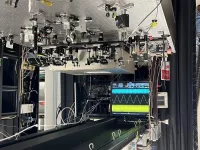(Press-News.org) Imagine a sweater that powers electronics to monitor your health or charge your mobile phone while running. This development faces challenges because of the lack of materials that both conduct electricity stably and are well suited for textiles. Now a research group, led by Chalmers University of Technology in Sweden, presents an ordinary silk thread, coated with a conductive plastic material, that shows promising properties for turning textiles into electricity generators.
Thermoelectric textiles convert temperature differences, for example between our bodies and the surrounding air, into an electrical potential. This technology can be of great benefit in our everyday lives and in society. Connected to a sensor, the textiles can power these devices without the need for batteries. These sensors can be used to monitor our movements or measure our heartbeat.
Since the textiles must be worn close to the body, the materials used in them must meet high demands on safety and flexibility. The silk thread that the researchers tested has a coating made of a conducting polymer. It is a plastic material with a chemical structure that makes the material electrically conductive and well adapted to textiles.
“The polymers that we use are bendable, lightweight and are easy to use in both liquid and solid form. They are also non-toxic," says Mariavittoria Craighero, who is a doctoral student at the Department of Chemistry and Chemical Engineering at Chalmers University of Technology, and first author of a recently published study.
Enhanced stability and conductivity
The method used to make the electrically conductive thread is the same as used in previous studies within the same research project. Previously, the thread contained metals to maintain its stability in contact with air. Since then, advances have been made to manufacture the thread with only organic (carbon-based) polymers. In the current study, the researchers have developed a new type of thread with enhanced electrical conductivity and stability.
“We found the missing piece of the puzzle to make an optimal thread – a type of polymer that had recently been discovered. It has outstanding performance stability in contact with air, while at the same time having a very good ability to conduct electricity. By using polymers, we don't need any rare earth metals, which are common in electronics," says Mariavittoria Craighero.
To show how the new thread can be used in practice, the researchers manufactured two thermoelectric generators – a button sewn with the thread, and a piece of textile with sewn-in threads. When they placed the thermoelectric textiles between a hot and a cold surface, they could observe how the voltage increased on the measuring instrument. The effect depended on the temperature difference and the amount of conductive material in the textile. As an example, the larger piece of fabric showed about 6 millivolts at a temperature difference of 30 degrees Celsius. In combination with a voltage converter, it could theoretically be used to charge portable electronics via a USB connector. The researchers have also been able to show that the thread’s performance is maintained for at least a year. It is also machine washable.
"After seven washes, the thread retained two-thirds of its conducting properties. This is a very good result, although it needs to be improved significantly before it becomes commercially interesting," says Mariavittoria Craighero.
Can meet functions that these textiles require
The thermoelectric fabric and button cannot be produced efficiently outside the lab environment today. The material must be made and sewn in by hand, which is time-consuming. Just sewing it into the demonstrated fabric required four days of needlework. But the researchers see that the new thread has great potential and that it would be possible to develop an automated process and scale up.
“We have now shown that it is possible to produce conductive organic materials that can meet the functions and properties that these textiles require. This is an important step forward. There are fantastic opportunities in thermoelectric textiles and this research can be of great benefit to society," says Christian Müller, Professor at the Department of Chemistry and Chemical Engineering at Chalmers University of Technology and research leader of the study.
All images related to this press release can be downloaded via this link.
Footage from the lab at Chalmers University of Technology, Sweden, can be downloaded via this link.
More about the study
The scientific article Poly(benzodifurandione) Coated Silk Yarn for Thermoelectric Textiles is published in Advanced Science. Authors are Mariavittoria Craighero, Qifan Li, Zijin Zeng, Chunghyeon Choi, Youngseok Kim, Hyungsub Yoon, Tiefeng Liu, Przemysław Sowiński, Shuichi Haraguchi, Byungil Hwang, Besira Mihiretia, Simone Fabiano and Christian Müller. The researchers are active at Chalmers University of Technology, Linköping University and Chung-Ang University in Seoul, South Korea. The research has been funded by the EU's Horizon 2020 research and innovation programme, through the Marie Skłodowska-Curie project HORATES, the Knut and Alice Wallenberg Foundation, the European Research Council (ERC), the Swedish Research Council and Linköping University.
More about the research field
Interest in organic electronics with conjugated polymers has grown a lot in recent years. Conducting polymers have a chemical structure that allows them to conduct electricity similar to silicon, and at the same time they have the physical properties of plastic materials which makes them flexible. Research on conducting polymers is ongoing in many areas such as solar cells, the Internet of Things (IoT), augmented reality (AR), robotics and various types of portable electronics. In addition to the research group behind the current study, there are two other research groups active in the research field at the same department at Chalmers University of Technology.
For more information, please contact:
Mariavittoria Craighero, PhD student, Department of Chemistry and Chemical Engineering, Chalmers University of Technology, Sweden, marcra@chalmers.se
Christan Müller, Professor, Department of Chemistry and Chemical Engineering, Chalmers University of Technology, Sweden, +46 31 772 27 90, christian.muller@chalmers.se
Christian Müller speaks English, German and Swedish, Mariavittoria Craighero speaks English and Italian.
The contact persons can be available for live and pre-recorded interviews. At Chalmers, we have podcast studios and broadcast filming equipment on site and would be able to assist a request for a television, radio or podcast interview.
Image caption: A research group, led by Chalmers University of Technology in Sweden, presents an ordinary silk thread, coated with a conductive plastic material, that shows promising properties for turning textiles into electricity generators. Here, a button is sewn with the new thread.
Photo credit: Chalmers University of Technology | Hanna Magnusson
END
The silk thread that can turn clothes into charging stations
2024-10-31
ELSE PRESS RELEASES FROM THIS DATE:
Glaucoma drug shows promise against neurodegenerative diseases, animal studies suggest
2024-10-31
A drug commonly used to treat glaucoma has been shown in zebrafish and mice to protect against the build-up in the brain of the protein tau, which causes various forms of dementia and is implicated in Alzheimer’s disease.
Researchers in the UK Dementia Research Institute at the University of Cambridge screened more than 1,400 clinically-approved drug compounds using zebrafish genetically engineered to make them mimic so-called tauopathies. They discovered that drugs known as carbonic anhydrase inhibitors – of which the glaucoma drug methazolamide is one – clear tau build-up and reduce signs of the disease in zebrafish and mice carrying the mutant forms of tau ...
Human proteins identified that explain inter-individual differences in functional brain connectivity
2024-10-31
BIRMINGHAM, Ala. – A long-standing goal of neuroscience is to understand how molecules and cellular structures on a microscale give rise to communication between brain regions at the macroscale. A study published in Nature Neuroscience now identifies, for the first time, hundreds of brain proteins that explain inter-individual differences in functional connectivity and structural covariation in the human brain.
“A central goal of neuroscience is to develop an understanding of the brain that ultimately describes the mechanistic basis of human cognition and behavior,” said Jeremy Herskowitz, Ph.D., associate professor in the University of Alabama at Birmingham ...
A newly developed algorithm shows how a gene is expressed at microscopic resolution
2024-10-31
They say a picture is worth a thousand words.
A new method, developed by University of Michigan researchers, creates images that are worth many gigabytes of data, which could revolutionize the way biologists study gene expression. Seq-Scope, developed by Jun Hee Lee, Ph.D., Hyun Min Kang, Ph.D., and their colleagues, was first described in Cell in 2021 as the first method to analyze gene expression at sub micrometer-scale spatial resolution.
To compare, a single human hair ranges from 20 to 200 micrometers in width.
The team has since improved Seq-Scope, making it more versatile, ...
Why elephants never forget but fleas have, well, the attention span of a flea
2024-10-31
Researchers at the Complexity Science Hub and Santa Fe Institute have developed a model to calculate how quickly or slowly an organism should ideally learn in its surroundings. An organism’s ideal learning rate depends on the pace of environmental change and its life cycle, they say.
Every day, we wake to a world that is different, and we adjust to it. Businesses face new challenges and competitors and adapt or go bust. In biology, this is a question of survival: every organism, from bacteria to blue whales, faces the challenge of adapting to environments that ...
Childhood neglect associated with stroke, COPD, cognitive impairment, and depression
2024-10-31
Toronto, ON, – New research from the University of Toronto found that childhood neglect, even in the absence of childhood sexual abuse and physical abuse, is linked with a wide range of mental and physical health problems in adulthood.
“While a large body of research has established the detrimental impact of childhood physical and sexual abuse on adult health outcomes, much less is known about whether neglect, in the absence of abuse, has similar negative outcomes,” said first author, Linxiao Zhang, a PhD student at the Factor-Inwentash Faculty of Social Work (FIFSW) at the University of Toronto. “Our research underlines the importance of health professionals ...
Landmark 20-year study of climate change impact on permafrost forests
2024-10-31
In perhaps the first long-term study of CO2 fluxes in northern forests growing on permafrost, an Osaka Metropolitan University-led research team has found that climate change increased not only the sources of carbon, but also the CO2 sinks.
The 20-year observation from 2003-2022 in the interior of Alaska showed that while CO2 sinks turned into sources during the first decade, the second decade showed a nearly 20% increase in CO2 sinks.
Graduate School of Agriculture Associate Professor Masahito Ueyama and colleagues found that warming led to wetness, which in turn aided the growth of black spruce trees. During photosynthesis, the growing trees were using the increasing ...
Researchers take broadband high-resolution frequency combs into the UV
2024-10-31
WASHINGTON — Researchers have developed a new ultrafast laser platform that generates ultra-broadband ultraviolet (UV) frequency combs with an unprecedented one million comb lines, providing exceptional spectral resolution. The new approach, which also produces extremely accurate and stable frequencies, could enhance high-resolution atomic and molecular spectroscopy.
Optical frequency combs — which emit thousands of regularly spaced spectral lines — have transformed fields like metrology, spectroscopy and precision timekeeping via optical atomic clocks, earning the 2005 Nobel Prize in Physics.
The ...
Not going out is the “new normal” post-Covid, say experts
2024-10-31
Compared with just before the Covid-19 pandemic, people are spending nearly an hour less a day doing activities outside the home, behaviour that researchers say is a lasting consequence of the pandemic.
A new study published in the peer-reviewed Journal of the American Planning Association reveals an overall drop since 2019 of about 51 minutes in the daily time spent on out-of-home activities, plus an almost 12-minute reduction in time spent on daily travel such as driving or taking public transportation.
The analysis, based on a survey of 34,000 Americans, ...
Study shows broader screening methods help prevent spread of dangerous fungal pathogen in hospitals
2024-10-31
Study Shows Broader Screening Methods Help Prevent Spread of Dangerous Fungal Pathogen in Hospitals
Screening high-risk patients for Candida auris allows for early detection and implementation of infection control measures to prevent hospital outbreaks
Arlington, Va. — October 31, 2024 — A new study published today in the American Journal of Infection Control (AJIC) describes the outcome of a shift in hospital screening protocols for Candida auris, a dangerous and often drug-resistant fungal pathogen that spreads easily in hospital environments. A comparison of screening results and patient outcomes before ...
Research spotlight: Testing a model for depression care in Malawi using existing medical infrastructure
2024-10-31
How would you summarize your study for a lay audience?
We tested a model of depression care in Malawi, a low-income country in sub-Saharan Africa, that builds off the infrastructure of the country’s HIV delivery system. The intervention involved clinical officers who delivered medications for depression, and it involved lay personnel, people living in the community, to deliver psychotherapy. Unlike past research, we did not limit our evaluation to improvements in depression; we also looked at improvements in other chronic health conditions that participants had, and we measured effects on household members.
What knowledge gap does your study help to ...




